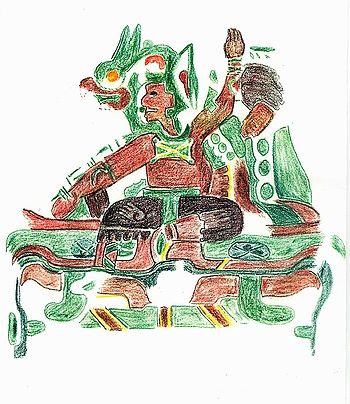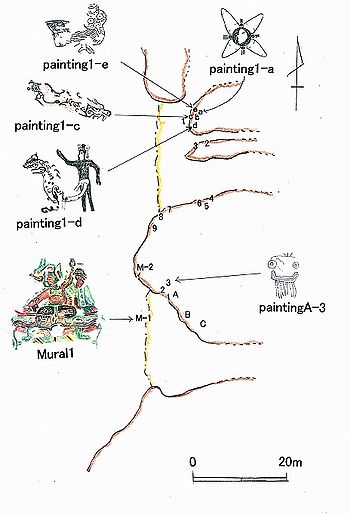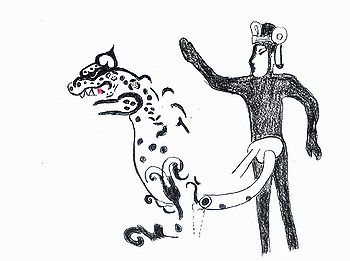
Oxtotitlán
Encyclopedia
 |
|
| Name: | Cueva de Oxtotitlán |
| Location | Chilapa de Álvarez Chilapa de Álvarez Chilapa de Álvarez, informally known as Chilapa, is a municipality in the Mexican state of Guerrero, approximately 54 kilometers east of state capital Chilpancingo. It is a very old town, its first official charter was issued by the Aztec government in the 15th century, after the area's conquest by... , Guerrero Guerrero Guerrero officially Estado Libre y Soberano de Guerrero is one of the 31 states which, with the Federal District, comprise the 32 Federal Entities of Mexico. It is divided in 81 municipalities and its capital city is Chilpancingo.... |
| Coordinates | 17°47′N 98°57′W |
| Culture | Olmec Olmec The Olmec were the first major Pre-Columbian civilization in Mexico. They lived in the tropical lowlands of south-central Mexico, in the modern-day states of Veracruz and Tabasco.... |
| Language | |
| Period | Mesoamerican Preclassical |
| Foundation | Approx. 900 BCE . |
| Decline | Mesoamerican Late Classical. |
| INAH Official Page | Non existent |

Rock shelter
A rock shelter is a shallow cave-like opening at the base of a bluff or cliff....
and archaeological site
Archaeological site
An archaeological site is a place in which evidence of past activity is preserved , and which has been, or may be, investigated using the discipline of archaeology and represents a part of the archaeological record.Beyond this, the definition and geographical extent of a 'site' can vary widely,...
in Chilapa de Álvarez
Chilapa de Álvarez
Chilapa de Álvarez, informally known as Chilapa, is a municipality in the Mexican state of Guerrero, approximately 54 kilometers east of state capital Chilpancingo. It is a very old town, its first official charter was issued by the Aztec government in the 15th century, after the area's conquest by...
, Mexican state of Guerrero
Guerrero
Guerrero officially Estado Libre y Soberano de Guerrero is one of the 31 states which, with the Federal District, comprise the 32 Federal Entities of Mexico. It is divided in 81 municipalities and its capital city is Chilpancingo....
that contains mural
Mural
A mural is any piece of artwork painted or applied directly on a wall, ceiling or other large permanent surface. A particularly distinguishing characteristic of mural painting is that the architectural elements of the given space are harmoniously incorporated into the picture.-History:Murals of...
s linked to the Olmec
Olmec
The Olmec were the first major Pre-Columbian civilization in Mexico. They lived in the tropical lowlands of south-central Mexico, in the modern-day states of Veracruz and Tabasco....
motif
Motif (art)
In art, a motif is an element of a pattern, an image or part of one, or a theme. A motif may be repeated in a design or composition, often many times, or may just occur once in a work. A motif may be an element in the iconography of a particular subject or type of subject that is seen in other...
s and iconography
Iconography
Iconography is the branch of art history which studies the identification, description, and the interpretation of the content of images. The word iconography literally means "image writing", and comes from the Greek "image" and "to write". A secondary meaning is the painting of icons in the...
. Along with the nearby Juxtlahuaca
Juxtlahuaca
Juxtlahuaca is a cave and archaeological site in the Mexican state of Guerrero containing murals linked to the Olmec motifs and iconography. Along with the nearby Oxtotitlán cave, Juxtlahuaca walls contain the earliest sophisticated painted art known in Mesoamerica, and only known example of...
cave, the Oxtotitlán rock paintings represent the "earliest sophisticated painted art known in Mesoamerica
Mesoamerica
Mesoamerica is a region and culture area in the Americas, extending approximately from central Mexico to Belize, Guatemala, El Salvador, Honduras, Nicaragua, and Costa Rica, within which a number of pre-Columbian societies flourished before the Spanish colonization of the Americas in the 15th and...
", thus far. Unlike Juxtlahuaca, however, the Oxtotitlán paintings are not deep in a cave system but rather occupy two shallow grottos on a cliff face.
The paintings have been variously dated to perhaps 900 BCE
Common Era
Common Era ,abbreviated as CE, is an alternative designation for the calendar era originally introduced by Dionysius Exiguus in the 6th century, traditionally identified with Anno Domini .Dates before the year 1 CE are indicated by the usage of BCE, short for Before the Common Era Common Era...
or 800 to 500 BCE. It is not known what group or society painted them. It is also not known how Olmec-influenced art came to be painted hundreds of kilometers (or miles) from the Olmec heartland
Olmec heartland
The Olmec heartland is the southern portion of Mexico's Gulf Coast region between the Tuxtla mountains and the Olmec archaeological site of La Venta, extending roughly 80 km inland from the Gulf of Mexico coastline at its deepest...
, although caves are prominent on many Olmec-style monuments, including La Venta Altars 4 and 5.
Description

The best-known samples of Oxtotitlán paintings are those part of the core group. These are two Polychrome
Polychrome
Polychrome is one of the terms used to describe the use of multiple colors in one entity. It has also been defined as "The practice of decorating architectural elements, sculpture, etc., in a variety of colors." Polychromatic light is composed of a number of different wavelengths...
murals, one of which represent a sitting character on a mythological Olmec serpent, wearing a mask, according to Grove, could be a representation of an Owl
Owl
Owls are a group of birds that belong to the order Strigiformes, constituting 200 bird of prey species. Most are solitary and nocturnal, with some exceptions . Owls hunt mostly small mammals, insects, and other birds, although a few species specialize in hunting fish...
. The other mural of the central group has been severely damaged by time and the environment, making it difficult to identify. Internal murals are monochrome (black and white), or bi-chromos, combining elements of red and black.
Unlike Juxtlahuaca, it is possible that Oxtotitlán contained a housing area, because ceramic materials have been found in the vicinity of the Quiotepec Hill.
Distribution
The paintings are distributed in three areas with a separate type of painting assigned to each area.North grotto
The paintings are smaller, were created using black pigment, and feature animals, humans, and fantastic creatures.South grotto
The paintings here, by contrast, are in red and generally feature geometric designs.Central grotto
Between the north and south grottos are two large polychrome murals, over the cave entrance.Mural 1
This Mural is situated above the mouth to the south grotto, and portrays what is most likely a ruler seated upon a throne similar to La VentaLa Venta
La Venta is a pre-Columbian archaeological site of the Olmec civilization located in the present-day Mexican state of Tabasco. Some of the artifacts have been moved to the museum "Parque - Museo de La Venta", which is in Villahermosa, the capital of Tabasco....
's Altar 4 or 5. The eyes of a primal cave monster, showing Olmec iconic crossed-bars, can be seen on the top edge of the throne (note that the ruler is also wearing a crossed-bars pectoral
Gorget
A gorget originally was a steel or leather collar designed to protect the throat. It was a feature of older types of armour and intended to protect against swords and other non-projectile weapons...
, perhaps linking him directly with the monster).
The ruler, painted in vibrant reds, greens, and browns, is wearing a bird mask, generally identified as that of an owl, as well as a green-feathered costume. Seated on the throne, his left leg is tucked underneath him while the right dangles down, similar to a pose found on the fragmentary Laguna de los Cerros
Laguna de los Cerros
Laguna de los Cerros is a little-excavated Olmec and Classical era archaeological site, located in the vicinity of Corral Nuevo, within the municipality of Acayucan, in the Mexican state of Veracruz, in the southern foothills of the Tuxtla Mountains, some 30 kilometers south of the Catemaco.With...
Monument 9.
Mural 2

It seems to picture a human in jaguar clothing or otherwise associated with a jaguar.
Also of particular note is the north grotto's "most striking creation", Painting 1-D, which features an ithyphallic
Phallus
A phallus is an erect penis, a penis-shaped object such as a dildo, or a mimetic image of an erect penis. Any object that symbolically resembles a penis may also be referred to as a phallus; however, such objects are more often referred to as being phallic...
man standing behind what appears to be a rearing jaguar. The man is painted in black outline, with a headress. His exaggerated genitals that point to the jaguar have led to speculation that this is a scene of a man copulating with a jaguar.
Preservation and visitation
In the 30 years following its re-discovery, the site was the object of graffiti and poor maintenance. This was addressed in the 2002 by the restoration work of Sandra Cruz, under the auspices of the National Coordination of Conservation of the Cultural Patrimony, INAH-Churubusco.Although the paintings can still be viewed, visitors must first register with the local caretakers in the nearby village of Acatlán.

